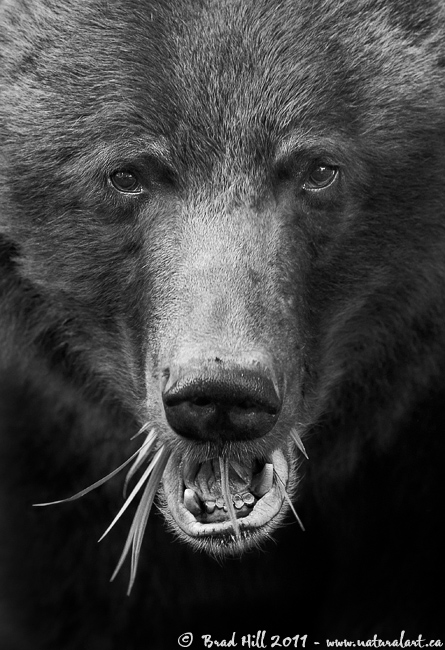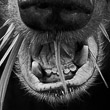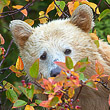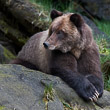Availability: Undetermined - Enquiries?
In the Field
Totally Hung! Khutzeymateen Inlet (Great Bear Rainforest), BC, Canada. May 28, 2011.
I was going to call this image "From Lemons to Lemonade" but thought the title I chose more aptly described the situation I was in when I shot this. And, of course, it's possible many may think this image IS a lemon and not sweet at all, so the "Lemons to Lemonade" title might have been a little presumptuous!
Have you ever been in the situation where you're faced with a great scene but are totally hung with the wrong configuration of gear in your hands? Most of us have - and that's exactly what happened when I shot this image. I captured this shot from the front of a Zodiac boat during a photo tour I was leading in the Khutzeymateen in late May 2011. Anyway, just moments before shooting this I was doing the "intrepid guide" thing and had got out of the Zodiac to lift and push it off some rocks. When I freed the boat I had to jump/dive in and so I ended up in the front of the Zodiac with all my gear at the back of the boat. Someone handed me my camera, which was fitted with a 400mm lens with rear-mounted polarizer installed. But all the rest of my gear was at the back of the boat - way out of my reach. And...just moments later we were face-to-face with a female grizzly close enough to us that a 200mm lens would have been ample for a full frame shot. The bear was in the shade. I couldn't move around in the boat so changing lenses (or even pulling of my polarizer) was out of the question. What to do?
Well - all I COULD do was live with what I had in my hands. So it was portrait time! The bear was so close that I was in a situation where the head pretty much filled the frame with my 400mm lens. Which meant I had to stop down some to get all the critical bits into focus. And, because I was hand-holding the camera I needed some shutter speed to get a sharp image. And I had a light-sucking polarizing filter on. So...it was f6.3, 1/250s, and...6400 ISO! Well...pixels are cheap so why not try? This is the result...
What drove the conversion to Black & White (B&W)? I commonly hear folks say "well, this image had poor colour in it so I converted to black & white." I look at things a little differently when it comes to B&W. I LIKED how this image came out in colour, but when I looked at it critically I saw a very wide tonal range (some true blacks, some whites or near whites) AND a whole zone of nearly continuous mid-tones (in the bear's fur). Which made me think there was the potential for a strong B&W image in all that colour. Being more direct...I think it's often a mistake to take a mid-tone dominated image with "poor" colour and think it will work better in B&W - the end result is often a drab, grey-on-grey image with little to draw one's eye. You want good B&W images? Forget the images that "don't look good in colour" - watch for wide tonal ranges and look for an image with GOOD colour in it!
NOTE: This image was captured in a region of British Columbia known as "The Great Bear Rainforest". I offer both instructional photo tours and "photo op only" photo tours into the Great Bear Rainforest each spring and autumn. If you're interested in more information about one of these tours, details are available on the Photo Tours page of this website!
Behind the Camera
Totally Hung! Khutzeymateen Inlet (Great Bear Rainforest), BC, Canada. May 28, 2011.
Digital Capture; RAW 14-bit format; ISO 6400.
Nikon D3s with Nikkor 400mm f2.8 VR lens. Hand-held from floating Zodiac inflatable boat (VR on and in normal mode).
1/250s @ f6.3; -0.33 stop compensation from matrix-metered exposure setting.
At the Computer
Totally Hung! Khutzeymateen Inlet (Great Bear Rainforest), BC, Canada. May 28, 2011.
RAW Conversion to 16-bit TIFF, including first-pass/capture sharpening using Phase One's Capture One Pro 6. Three raw conversions varying in exposure settings over a 1.0 stop range.
Further digital corrections on 16-bit TIFF file using Adobe's Photoshop CS5 and LightCraft's Lightzone. For colour version: Photoshop adjustments including blending of 3 exposure versions, selective exposure and tone curve adjustment, and selective colour saturation and desaturation. Final tonemapping and contrast/tone tweaking - especially to midtones on the bear's head - performed with LightZone using the tonemapper/re-light tool. For B&W conversion/version: conversion to B&W performed using Black & White adjustment layer (with lots of tweaking to various colour channels), followed by selective curves adjustment (2 adjustment layers) and selective exposure (2 more adjustment layers). Followed by 3 passes of very selective sharpening for web output.
Conservation
Totally Hung! Khutzeymateen Inlet (Great Bear Rainforest), BC, Canada. May 28, 2011.
Ten percent of the revenue generated by this image will be donated to Raincoast*.
Species Status in Canada**: Special Concern (May 2002).
While Grizzly Bears (Ursus arctos) are not technically listed as "Endangered" in Canada, they have been extirpated from most of their historical range. Grizzly Bears are far more sensitive to intrusion/disturbance in their habitat than are Black Bears and are being increasingly forced into marginal habitat by human encroachment. The Great Bear Rainforest along the central and northern coast of British Columbia is one of the last strongholds of the Grizzly Bear in Canada, and even this population is coming under increasing pressure.
On December 18, 2017 the government of British Columbia banned grizzly hunting across the entire province. This major conservation victory came after decades of tireless work by many dedicated conservationists and ecologists and, most importantly, it reflects the opinion of the vast majority of British Columbians. And, it means that AT LEAST while the current government remains in power grizzlies are finally "safe" in British Columbia.
Now that we've at least temporarily won the battle to save grizzlies in BC, it's time to re-focus our efforts toward protecting ALL of BC's carnivores, including Gray Wolves, Black Bears, Cougars, Wolverines, and more! Simply put, there are no ecological, economic, or ethical arguments supporting the trophy hunting of carnivores.
In a great first step towards ending the hunting of carnivores throughout BC the Raincoast Conservation Foundation has developed a program designed to protect ALL carnivores within the Great Bear Rainforest. Details about this program can be found on this page on Raincoast's website. Check it out and, better yet, make a donation to help Raincoast purchase the remaining commercial hunting tenures in the Great Bear!
*The Raincoast Conservation Society (and Foundation) is an effective and efficient organization that has been fighting for protection of this unique habitat. If you are looking for a meaningful way to contribute to the conservation of this amazing ecosystem, Raincoast will provide maximal "bang" for your conservation dollars.
**as determined by COSEWIC: The Committee on the Status of Endangered Wildlife in Canada

























